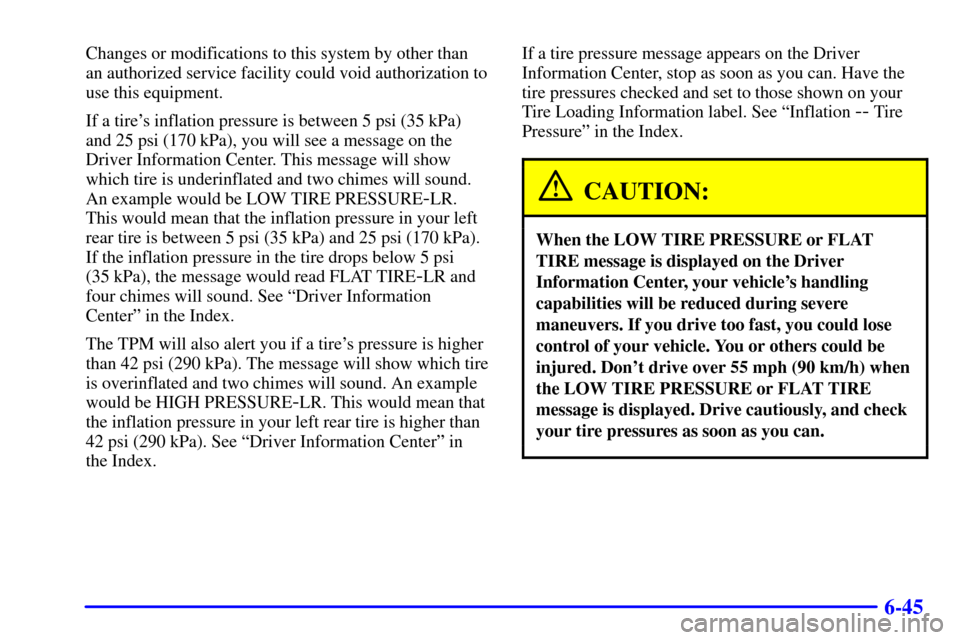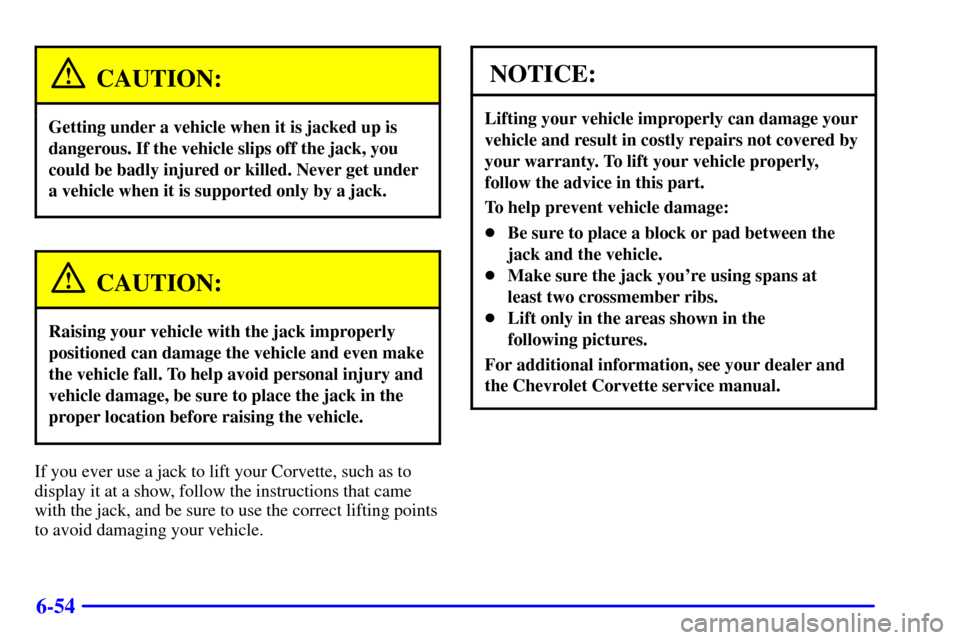Page 285 of 383

6-16 When to Change Engine Oil
Your vehicle has a computer that lets you know when to
change your engine oil. This is not based on mileage,
but on engine revolutions and engine operating
temperature. When the computer has calculated that the
oil needs changing, the GM Oil Life System� will
indicate that a change is necessary. The mileage between
oil changes will vary depending on how you drive your
vehicle
-- usually between 3,000 miles (5 000 km) and
15,000 miles (25 000 km) since your last oil and filter
change. Under severe conditions, the system may
come on before 3,000 miles (5 000 km). Never drive
your vehicle more than 15,000 miles (25 000 km)
or 12 months (whichever occurs first) without an
oil change. Use engine oil meeting the GM
Standard GM4718M.
The system won't detect dust in the oil. So, if you drive
in a dusty area, be sure to change your oil and filter
every 3,000 miles (5 000 km) or sooner if the CHANGE
OIL SOON message appears. Remember to reset the
Engine Oil Life Monitor whenever the oil is changed.
How to Reset the Change Oil Soon Message
To reset the CHANGE OIL SOON message after an oil
change, do the following:
1. Turn the ignition to ON, with the engine off.
2. Press the TRIP button so the OIL LIFE percentage
is displayed.
3. Press RESET and hold for two seconds. OIL LIFE
REMAIN 100% will appear.
What to Do with Used Oil
Did you know that used engine oil contains certain
elements that may be unhealthy for your skin and could
even cause cancer? Don't let used oil stay on your skin for
very long. Clean your skin and nails with soap and water,
or a good hand cleaner. Wash or throw away clothing or
rags containing used engine oil. See the manufacturer's
warnings about the use and disposal of oil products.
Used oil can be a real threat to the environment. If you
change your own oil, be sure to drain all free
-flowing oil
from the filter before disposal. Don't ever dispose of oil
by putting it in the trash, pouring it on the ground, into
sewers, or into streams or bodies of water. Instead,
recycle it by taking it to a place that collects used oil. If
you have a problem properly disposing of your used oil,
ask your dealer, a service station or a local recycling
center for help.
Page 313 of 383

6-44
How to Check
Use a good quality pocket
-type gage to check tire
pressure. You can't tell if your tires are properly inflated
simply by looking at them. Radial tires may look
properly inflated even when they're underinflated.
Be sure to put the valve caps back on the valve
stems. They help prevent leaks by keeping out dirt
and moisture.
If your vehicle is equipped with the Tire Pressure
Monitor, you can check tire inflation pressures while
driving. After you've reached a speed of 15 mph
(24 kmh) or more, press and release the GAGES button
on the Driver Information Center (DIC) until the front
tire pressures are displayed. Then, press and release the
GAGES button for the rear tire pressures. If the display
doesn't show tire pressure, or if the SERVICE TIRE
MON SYS message appears, see your dealer for service.
For more information, see ªTire Pressure Monitorº and
ªDriver Information Center (DIC)º in the Index.
Tire Pressure Monitor (If Equipped)
The Tire Pressure Monitor (TPM) has a sensor on
each road wheel that transmits to a receiver on the
instrument panel.
The system operates on a radio frequency subject to
Federal Communications Commission (FCC) Rules and
with Industry and Science Canada.
This device complies with Part 15 of the FCC Rules.
Operation is subject to the following two conditions:
(1) this device may not cause harmful interference,
and (2) this device must accept any interference
received, including interference that may cause
undesired operation.
This device complies with RSS
-210 of Industry and
Science Canada. Operation is subject to the following
two conditions: (1) this device may not cause
interference, and (2) this device must accept any
interference received, including interference that may
cause undesired operation of the device.
Page 314 of 383

6-45
Changes or modifications to this system by other than
an authorized service facility could void authorization to
use this equipment.
If a tire's inflation pressure is between 5 psi (35 kPa)
and 25 psi (170 kPa), you will see a message on the
Driver Information Center. This message will show
which tire is underinflated and two chimes will sound.
An example would be LOW TIRE PRESSURE
-LR.
This would mean that the inflation pressure in your left
rear tire is between 5 psi (35 kPa) and 25 psi (170 kPa).
If the inflation pressure in the tire drops below 5 psi
(35 kPa), the message would read FLAT TIRE
-LR and
four chimes will sound. See ªDriver Information
Centerº in the Index.
The TPM will also alert you if a tire's pressure is higher
than 42 psi (290 kPa). The message will show which tire
is overinflated and two chimes will sound. An example
would be HIGH PRESSURE
-LR. This would mean that
the inflation pressure in your left rear tire is higher than
42 psi (290 kPa). See ªDriver Information Centerº in
the Index.If a tire pressure message appears on the Driver
Information Center, stop as soon as you can. Have the
tire pressures checked and set to those shown on your
Tire Loading Information label. See ªInflation
-- Tire
Pressureº in the Index.
CAUTION:
When the LOW TIRE PRESSURE or FLAT
TIRE message is displayed on the Driver
Information Center, your vehicle's handling
capabilities will be reduced during severe
maneuvers. If you drive too fast, you could lose
control of your vehicle. You or others could be
injured. Don't drive over 55 mph (90 km/h) when
the LOW TIRE PRESSURE or FLAT TIRE
message is displayed. Drive cautiously, and check
your tire pressures as soon as you can.
Page 323 of 383

6-54
CAUTION:
Getting under a vehicle when it is jacked up is
dangerous. If the vehicle slips off the jack, you
could be badly injured or killed. Never get under
a vehicle when it is supported only by a jack.
CAUTION:
Raising your vehicle with the jack improperly
positioned can damage the vehicle and even make
the vehicle fall. To help avoid personal injury and
vehicle damage, be sure to place the jack in the
proper location before raising the vehicle.
If you ever use a jack to lift your Corvette, such as to
display it at a show, follow the instructions that came
with the jack, and be sure to use the correct lifting points
to avoid damaging your vehicle.
NOTICE:
Lifting your vehicle improperly can damage your
vehicle and result in costly repairs not covered by
your warranty. To lift your vehicle properly,
follow the advice in this part.
To help prevent vehicle damage:
�Be sure to place a block or pad between the
jack and the vehicle.
�Make sure the jack you're using spans at
least two crossmember ribs.
�Lift only in the areas shown in the
following pictures.
For additional information, see your dealer and
the Chevrolet Corvette service manual.